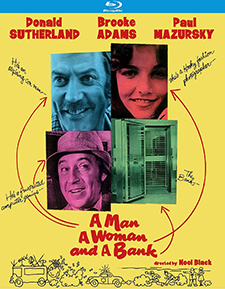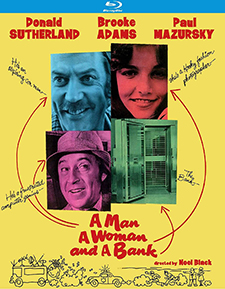Man, a Woman, and a Bank, A (Blu-ray Review)

Director
Noel BlackRelease Date(s)
1979 (May 26, 2020)Studio(s)
AVCO Embassy Pictures (Kino Lorber Studio Classics)- Film/Program Grade: C-
- Video Grade: B
- Audio Grade: B-
- Extras Grade: B+
Review
The heist is a reliable subject for movies. It provides a combination of detailed planning, excitement, and suspense. Notable examples include The Asphalt Jungle, Dog Day Afternoon, The Thomas Crown Affair, Oceans Eleven, and The Italian Job. The central plot tends to focus on the conspiracy, preparation, execution, and aftermath of the theft of a large sum of money or other valuables. A Man, a Woman, and a Bank is a late 1970s entry in the genre.
Reese Halperin (Donald Sutherland) and computer wiz Norman Barrie (Paul Mazursky) sit at an elaborate table-top miniature of a Vancouver bank that they intend to rob. The model offers them a run-through to make sure everything goes smoothly. With extreme close-ups, we watch model vans, elevators, and a miniature doll that moves along a track, follow the coordinated steps to assure a perfect crime. Norman is nervous and brings up the downside if they get caught—a long prison sentence. But Reese calmly reassures him that nothing can go wrong.
The targeted bank is under construction, which enables the two would-be thieves to get onto the property and fiddle with alarm systems. Wearing a hard hat to look as if he belongs there so he can case the construction site, Reese runs into photographer Stacey Bishop (Brooke Adams), who’s taking pictures for the bank’s ad campaign. She snaps a few of Reese as he leaves the foreman’s office with stolen blueprints of the bank. Realizing these photos made public could put a serious dent in the robbery plans, Reese makes note of the address on Stacey’s camera case, goes to her apartment, and discovers her with boyfriend Peter (Allan Kolman). Reese soon develops romantic feelings for Stacey despite the presence of annoying and arrogant Peter.
From here, the heist plot goes on hold as the growing relationship between Reese and Stacey takes center stage. The chemistry between the two actors works, but what should have been a tangential subplot hijacks the story for far too long. Director Noel Black gets back to the robbery eventually but deals with it in perfunctory fashion instead of suspensefully taking us step by step through the process. This would have nicely bookended the opening as we could compare the real heist with the erector set model.
If nothing else, a caper film requires viewers to be completely engaged. This can be accomplished by building suspense and keeping focus on the characters as they deal with unanticipated obstacles and delays. Instead, the director provides a flat denouement without any big surprises.
Sutherland walks through his performance showing little emotion, even in his scenes with Adams, who injects her performance with some spirit. Mazursky is an interesting choice for Reese’s partner in crime. His Norman is a family man undergoing domestic issues and constantly thinks of worst-case scenarios for the heist, infusing some humor into an otherwise sluggish film. He’s also the most natural actor of the three principals.
Back in the 1930s or 1940s, A Man, a Woman, and a Bank would have been a second feature, a B movie, or a programmer. The stars do not exactly shine, and the plot is handled languorously by an unimaginative director. The screenplay by Raynold Gideon (and four other writers) plods along with too many extraneous or overly lengthy scenes. If you hang around long enough, anticipating a solid, exciting payoff, you’ll wind up disappointed.
Featuring 1080p resolution, the film is presented on Blu-ray by Kino Lorber Studio Classics in the widescreen aspect ratio of 1.78:1. The print does not contain scratches, dirt specks, or other visual distractions. The color palette is fairly wide-ranging, with no hues ever dominating. Clarity is excellent, with details nicely delineated, including close-ups of the erector set model and patterns in clothing. Strands of hair from Sutherland and Adams appear distinct and individual, rather than blending into a helmet look. Outdoor scenes look natural. Jack Cardiff uses only one zoom that stands out because it’s the only shot that doesn’t duplicate what the human eye can do. A few lens flares occur at different points. Two lovely compositions stand out—one featuring Stacey in front of a body of water giddily dancing on a tree stump under an overcast twilight sky, and the other showing Reese and Stacey at a table illuminated by candle light. In another scene, Reese is bathed in green light from an indoor waterfall as he walks by. A shot of the two leads at the front of a tugboat is a forerunner of the famous scene in Titanic in which Leonardo DiCaprio and Kate Winslet also stand at the bow of the ship.
The soundtrack is English 2.0 DTS-High Definition Master Audio, with optional subtitles in English SDH. Dialogue is sharp and precise throughout, even though Sutherland tends to speak softly. Bill Conti’s score is a distraction. It doesn’t suit the subject matter and sounds intrusive. This may be due to the fact that Conti was confused by the many tendrils of the film and was never able to settle into a consistent approach to the music, which is disappointing since his score for Rocky is so perfect for its subject matter. The blend of dialogue with ambient street sounds is well mixed, providing the sound of a bustling metropolitan area.
Bonus materials include two audio commentaries and five theatrical trailers.
Audio Commentary #1 – Director Noel Black and producer Peter Samuelson discuss the film in a commentary recorded in 2002. A number of scenes between Donald Sutherland and Paul Mazursky were improvised, which caused problems with matching shots in coverage. At the time of the commentary, Sutherland had appeared in 133 films. The movie was supposed to have been financed by AVCO Embassy and Canadian tax shelters, but Canadian law changed, leaving the producers with half the funds needed to make the film. Fortunately, an investor was found and the production got underway. Certain scenes feature an early use of Steadicam. The production design involved creating sets for a building that hadn’t been built and including lots of electronic devices. The script was written by the team that later wrote Starman and Stand by Me. In actual interior locations, lights couldn’t be placed above the actors, so large, heavy lights called brutes had to be brought in. Composer Bill Conti had written 140 film scores. Sutherland and Adams had recently starred together in Philip Kaufman’s Invasion of the Body Snatchers.
Audio Commentary #2 – Film historians Dean Brand and Andrew Nette engage in an easygoing conversation about the film. They note that both Sutherland and Mazursky play laconic characters, and think Mazursky’s performance is too low-key. The structure of the film is problematic because a number of scenes do not connect with the actual robbery. The photo that Stacey takes of Reese that eventually becomes public and the character of Peter never really amount to much. “It’s almost like two separate films are running alongside each other.” Director Black seems more interested in the relationships than the heist. A lengthy discussion is devoted to Black’s Pretty Poison starring Anthony Perkins and Tuesday Weld. They note the pre-9/11 depiction of how easy it was to get on a plane. The film is “competent” but doesn’t exhibit a personal vision of the director, who is not “ostentatious” in his choices. “The film is confused… at what it wants to be.”
Theatrical Trailers – The following trailers are included: A Man, a Woman, and a Bank, The Great Train Robbery, Ordeal by Innocence, The Rosary Murders, and The Puppet Masters.
– Dennis Seuling

